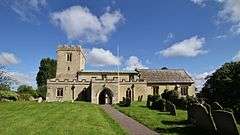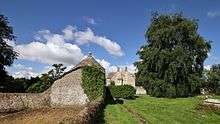Longworth
Longworth is a village and civil parish in the Vale of White Horse, England. It was part of Berkshire until the 1974 boundary changes transferred it to Oxfordshire. The village lies about 7 miles (11 km) west of Abingdon-on-Thames and 9 miles (14 km) south-west of Oxford. The 2011 Census recorded the parish population as 566.[1] The parish is bounded by the River Thames to the north, the A420 road to the south, and field boundaries to the east and west. The land slopes generally from the A420 to the river, except at Harrowdown Hill near the north-east corner of the parish, whose summit is 325 feet (99 m).
| Longworth | |
|---|---|
 St Mary's parish church | |
 Longworth Location within Oxfordshire | |
| Population | 566 (2011 Census) |
| OS grid reference | SU3999 |
| Civil parish |
|
| District | |
| Shire county | |
| Region | |
| Country | England |
| Sovereign state | United Kingdom |
| Post town | Abingdon |
| Postcode district | OX13 |
| Dialling code | 01865 |
| Police | Thames Valley |
| Fire | Oxfordshire |
| Ambulance | South Central |
| UK Parliament | |
| Website | Longworth Village on the Web |
Parish church
The oldest parts of the Anglican St Mary's Church, Longworth are from the 13th century, the current chancel, west tower and north aisle from the 15th.[2] It is a Grade I listed building.[2]
The parish belongs to the benefice of Cherbury with Gainfield.[3] J. R. Illingworth, a theologian and philosopher, was Rector of St Mary's from 1883 to 1915.
Manor house
Longworth's original manor house can be dated to the early 17th century, when it was built by the judge, Sir Henry Marten about a mile south of the village on the edge of the Vale of White Horse.[4] It was occupied later by his son, Henry Marten, the regicide and republican. In the 20th century, it was home to Sir Clarendon Hyde, a Liberal MP and businessman.[5]
Today's manor house was originally known as Manor Farm. It stands just west of the parish church.[5] It was built in the late 17th century, and remodelled and extended in the early 20th. The house is a Grade II listed building.[6] It was home to Colonel Granville Walton, a leading Scout.[7]
Economic and social history

A farmstead about 3⁄4 mile (1.2 km) south of the village has a 17th-century tithe barn, with a queen post roof seven bays long. It is Grade II* listed building.[8] and a scheduled monument.[9]
The Old Rectory at Longworth was the birthplace on 7 June 1825 of the novelist R. D. Blackmore, author of Lorna Doone, whose father was briefly curate-in-charge of the parish.[10]
Harrowdown Hill is where biological warfare expert David Kelly died in 2003 during the Iraqi weapons of mass destruction controversy.[11] This gave rise to a public enquiry that concluded with the Hutton Report. The government's handling of the matter is questioned in a song by Thom Yorke entitled Harrowdown Hill.
Longworth was once home to a Congregational chapel, built in 1848, and to a Primitive Methodist chapel, built in 1861.[5] Both chapels have now been converted into residences.
Amenities
Longworth has a non-denominational county primary school.[12]
There are no bus routes into the village apart from school buses to Faringdon Community College and Matthew Arnold School. The closest stops are in Southmoor (1.4 miles/2.3 km), Kingston Bagpuize (1.9 miles/3.1 km) and Newbridge (2.8 miles/4.5 km).
Public houses

There is a pub in the village, the Blue Boar, which dates from 1606 and has a thatched roof.[13][14] The Lamb and Flag, now a dwelling about 1¼ miles (2.0 km) south-west of the village, was in the parish until boundary changes in 2011 transferred it to Kingston Bagpuize with Southmoor. These changes brought the Maybush Inn at Newbridge into the parish.
The white boar and the white rose on the Blue Boar pub sign are symbols of King Richard III. The blue boar was the personal badge of the De Vere family as Earls of Oxford. It is claimed that when Richard was killed at the Battle of Bosworth in 1485, any White Boar pub signs were quickly repainted as Blue Boars, to signify that the white boar was dead and the blue had prevailed.
Blue Boar RFC
Blue Boar Rugby Football Club,[15] based at the Blue Boar pub in Longworth, normally plays home games at the Oxford R.F.C. ground. It played its first game of rugby in March 1977, after a challenge by staff of Blackwells Bookshop in Oxford.
In the following season, several more matches were arranged against local sides and the club affiliated to the Oxfordshire Rugby Football Union. The number and quality of its fixtures increased, and in May 1981 the club was elected to the Rugby Football Union. In September 1980 it made a first tour of Cornwall, followed by further visits in 1987, 1988 and 1989. Its first foreign tour in 1981 took 35 players and supporters to Brittany. The team returned there a year later. In 1991 the club was the first English RFU club to make an official tour of Hungary, hosted by the Hungarian Rugby Union. The club reached the final of the Oxfordshire Knockout Cup Plate competition in the 2003–2004 and 2008–2009 seasons.
References
- "Area: Longworth (Parish): Key Figures for 2011 Census: Key Statistics". Neighbourhood Statistics. Office for National Statistics. Retrieved 8 April 2016.
- Historic England. "Church of St Mary (Grade I) (1048616)". National Heritage List for England. Retrieved 8 April 2016.
- Archbishops' Council. "Longworth: St Mary, Longworth". A Church Near You. Church of England. Retrieved 8 April 2016.
- Lee, Sidney, ed. (1891). . Dictionary of National Biography. 28. London: Smith, Elder & Co.
- Page & Ditchfield 1924, p. 461.
- Historic England. "Longworth Manor (Grade II*) (1368400)". National Heritage List for England. Retrieved 22 May 2020.
- "St Mary's Church, Longworth" (PDF). www.cherbury-gainfield.org.uk. Retrieved 22 May 2020.
- Historic England. "Tithe Barn (Grade II*) (1387458)". National Heritage List for England. Retrieved 8 April 2016.
- Historic England. "Barn at Longworth House (hospital) (1006289)". National Heritage List for England. Retrieved 8 April 2016.
- Winn 2010, p. 45.
- "David Kelly laid to rest". BBC News. 6 August 2003. Retrieved 5 June 2008.
- Longworth Primary
- "Homepage | The Blue Boar". www.blueboarlongworth.co.uk. Retrieved 26 January 2019.
- Historic England. "The Blue Boar public house (Grade II) (1284516)". National Heritage List for England. Retrieved 8 April 2016.
- Blue Boar RFC Archived 7 January 2009 at the Wayback Machine
Sources and further reading

- Page, W. H.; Ditchfield, P. H., eds. (1924). A History of the County of Berkshire. Victoria County History. 4. assisted by John Hautenville Cope. London: The St Katherine Press. pp. 466–471.CS1 maint: ref=harv (link)
- Pevsner, Nikolaus (1966). Berkshire. The Buildings of England. Harmondsworth: Penguin Books. pp. 171–172.CS1 maint: ref=harv (link)
- Winn, Christopher (2010). I Never Knew That about the River Thames. London: Ebury Press. p. 45.CS1 maint: ref=harv (link)
